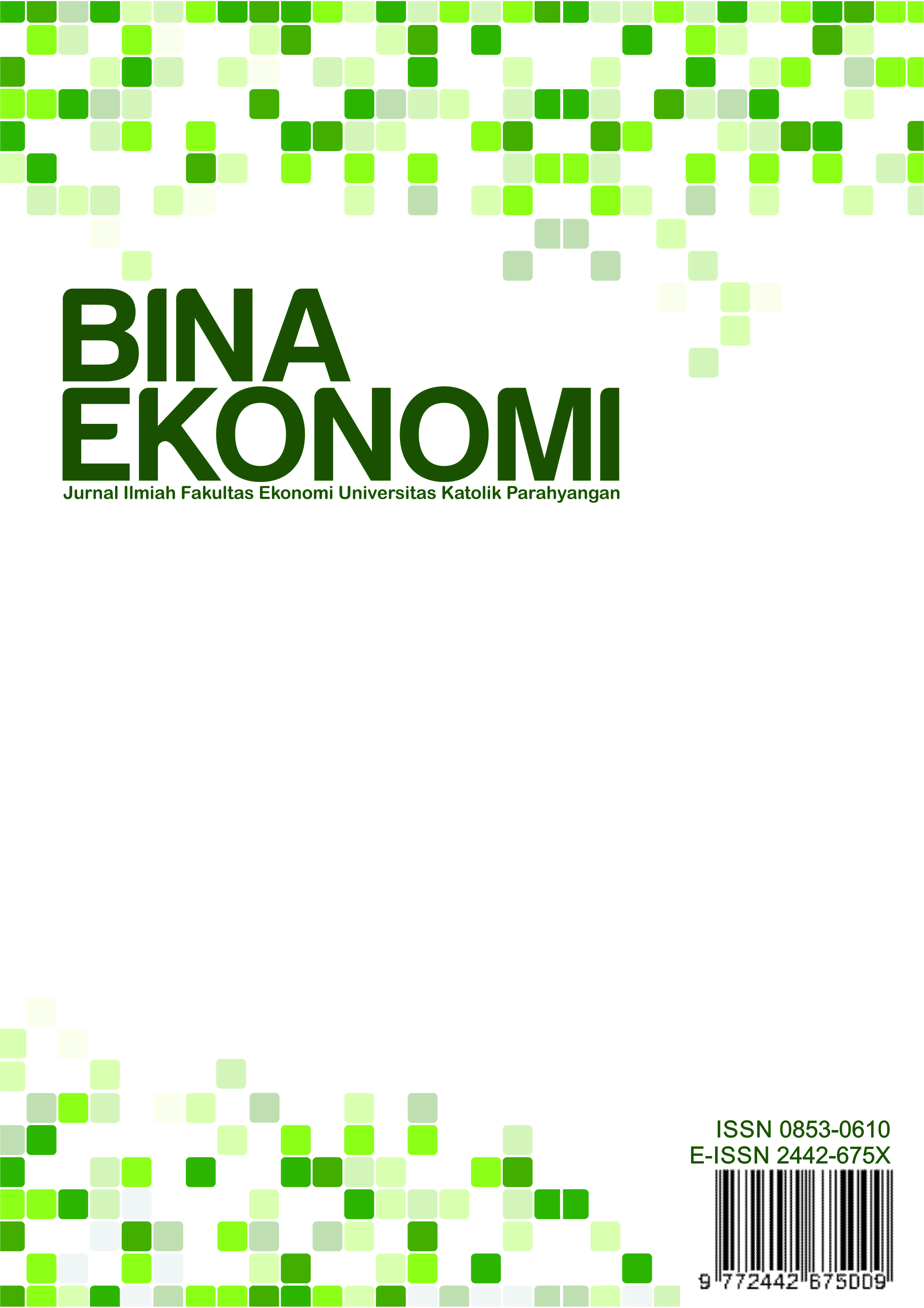IDENTIFIKASI STRUKTUR EKONOMI SEKTORAL DAN REGIONAL SELURUH PROVINSI DI INDONESIA MENGGUNAKAN ANALISIS NETWORK
DOI:
https://doi.org/10.26593/be.v27i2.6325.194-208Keywords:
Network Analysis; Centrality Measures; Economic Structure; IndonesiaAbstract
This study aims to identify key sectors in the economy of all provinces in Indonesia by network analysis using Indonesia's Inter-Regional Input-Output (IRIO) tables. The results of this study show that the most sensitive sector and the sector with the highest ranking in terms of having relationships with other important sectors are the manufacturing industry and its region is dominated by provinces on the island of Java. Furthermore, the sectors with the highest ratings in terms of their ability to influence resources among other sectors are the manufacturing, construction, transportation, and warehousing industries, and financial services and insurance sectors. As well as the results of community detection show that sectors that are in the same province and have close geographical distances tend to interact more often. The results of this study also show that the highest rankings of the sector as a whole are dominated by provinces on the island of Java while the lowest is by the Eastern Part of Indonesia.
References
Angelidis, G., Ioannidis, E., Makris, G., Antoniou, I., & Varsakelis, N. (2020). Competitive conditions in global value chain networks: An assessment using entropy and network analysis. Entropy, 22(10). https://doi.org/10.3390/E22101068
Armelly, A., Rusdi, M., & Pasaribu, E. (2021). Analisis sektor unggulan perekonomian Indonesia: Model input-output. Sorot, 16(2), 119. https://doi.org/10.31258/sorot.16.2.119-134
Blöchl, F., Theis, F. J., Vega-Redondo, F., & Fisher, E. O. N. (2011). Vertex centralities in input-output networks reveal the structure of modern economies. Physical Review E - Statistical, Nonlinear, and Soft Matter Physics, 83(4), 1–8. https://doi.org/10.1103/PhysRevE.83.046127
Cahyono, B., & Sumargo, B. (2005). Mengartikulasikan Tabel Input-Output dan Kerangka Analisisnya. The Winners, 6(1), 33. https://doi.org/10.21512/tw.v6i1.485
Can, U., & Alatas, B. (2019). A new direction in social network analysis: Online social network analysis problems and applications. Physica A: Statistical Mechanics and Its Applications, 535, 122372. https://doi.org/10.1016/j.physa.2019.122372
Cerina, F., Zhu, Z., Chessa, A., & Riccaboni, M. (2015). World input-output network. PLoS ONE, 10(7), 1–21. https://doi.org/10.1371/journal.pone.0134025
Cingolani, I., Panzarasa, P., & Tajoli, L. (2017). Countries’ positions in the international global value networks: Centrality and economic performance. Applied Network Science, 2(1). https://doi.org/10.1007/s41109-017-0041-4
Clauset, A., Newman, M. E. J., & Moore, C. (2004). Finding community structure in very large networks. Physical Review E - Statistical Physics, Plasmas, Fluids, and Related Interdisciplinary Topics, 70(6), 6. https://doi.org/10.1103/PhysRevE.70.066111
Cuello, F. A., Mansouri, F., & Hewings, G. J. D. (1992). The Identification of Structure at the Sectoral level: A Reformulation of the Hirschman-Rasmussen Key Sector Indices. Economic Systems Research, 4(4), 285–296. https://doi.org/10.1080/09535319200000027
de Santana Ribeiro, L. C., Pereira, E. J. de A. L., Perobelli, F. S., & Pereira, H. B. de B. (2022). Sectoral Interdependence, Network Analysis, and Regional Resilience in Brazil. Latin American Business Review, 0(0), 1–29. https://doi.org/10.1080/10978526.2022.2074441
Del Río-Chanona, R. M., Grujić, J., & Jensen, H. J. (2017). Trends of the world input and output network of global trade. PLoS ONE, 12(1), 1–14. https://doi.org/10.1371/journal.pone.0170817
DePaolis, F., Murphy, P., & Kaluza, M. C. D. (2020). Identifying Key Sectors in the Regional Economy: A Network Analysis Approach Using Input-Output Data. August. https://doi.org/10.21203/rs.3.rs-1666449/v1
Freeman, L. C. (1979). Centrality in social networks. Social Networks, 1(3), 215–239. https://doi.org/10.1016/0378-8733(78)90021-7
Jin, Y., Xu, Y., Li, R., Zhao, C., & Yuan, Z. (2022). Comprehensive Evaluation of China’s Input–Output Sector Status Based on the Entropy Weight-Social Network Analysis Method. Sustainability, 14(21), 14588. https://doi.org/10.3390/su142114588
Mankiw, N. G. (2019). Macroeconomics. Worth Publishers.
Martin, R., & Gardiner, B. (2019). The resilience of cities to economic shocks: A tale of four recessions (and the challenge of Brexit). Papers in Regional Science, 98(4), 1801–1832. https://doi.org/10.1111/pirs.12430
Newman, M. E. J. (2003). The structure and function of complex networks. SIAM Review, 45(2), 167–256. https://doi.org/10.1137/S003614450342480
Niemira, M., Collin, F., Szalkowska, A., Bielska, A., Chwialkowska, K., Reszec, J., Niklinski, J., Kwasniewski, M., & Kretowski, A. (2020). Molecular signature of subtypes of non-small-cell lung cancer by large-scale transcriptional profiling: Identification of key modules and genes by weighted gene co-expression network analysis (WGCNA). Cancers, 12(1). https://doi.org/10.3390/cancers12010037
Oinas, P., Trippl, M., & Höyssä, M. (2018). Regional industrial transformations in the interconnected global economy. Cambridge Journal of Regions, Economy and Society, 11(2), 227–240. https://doi.org/10.1093/cjres/rsy015
Opsahl, T., Agneessens, F., & Skvoretz, J. (2010). Node centrality in weighted networks: Generalizing degree and shortest paths. Social Networks, 32(3), 245–251. https://doi.org/10.1016/j.socnet.2010.03.006
Pons, P., & Latapy, M. (2006). Computing communities in large networks using random walks. Journal of Graph Algorithms and Applications, 10(2), 191–218. https://doi.org/10.7155/jgaa.00124
Rosvall, M., & Bergstrom, C. T. (2008). Maps of random walks on complex networks reveal community structure. Proceedings of the National Academy of Sciences of the United States of America, 105(4), 1118–1123. https://doi.org/10.1073/pnas.0706851105
Sun, X., An, H., & Liu, X. (2018). Network analysis of Chinese provincial economies. Physica A: Statistical Mechanics and Its Applications, 492, 1168–1180. https://doi.org/10.1016/j.physa.2017.11.045
Syofya, H., & Rahayu, S. (2018). Peran Sektor Pertanian terhadap Perekonomian Indonesia (Analisis Input-Output). Manajemen Dan Kewirausahaan, 9(3), 91. https://doi.org/10.31317/jmk.9.3.91-103.2018
Wang, T., Xiao, S., Yan, J., & Zhang, P. (2021). Regional and sectoral structures of the Chinese economy: A network perspective from multi-regional input–output tables. Physica A: Statistical Mechanics and Its Applications, 581, 126196. https://doi.org/10.1016/j.physa.2021.126196
Widyawati, R. F. (2017). Analisis Keterkaitan Sektor Pertanian Dan Pengaruhnya Terhadap Perekonomian Indonesia (Analisis Input Ouput). Jurnal Economia, 13(1), 14. https://doi.org/10.21831/economia.v13i1.11923
Xing, L., Dong, X., & Guan, J. (2017). Global industrial impact coefficient based on random walk process and inter-country input–output table. Physica A: Statistical Mechanics and Its Applications, 471, 576–591. https://doi.org/10.1016/j.physa.2016.12.070
Zhang, P., Wang, T., & Yan, J. (2021). PageRank centrality and algorithms for weighted, directed networks with applications to World Input-Output Tables. http://arxiv.org/abs/2104.02764


